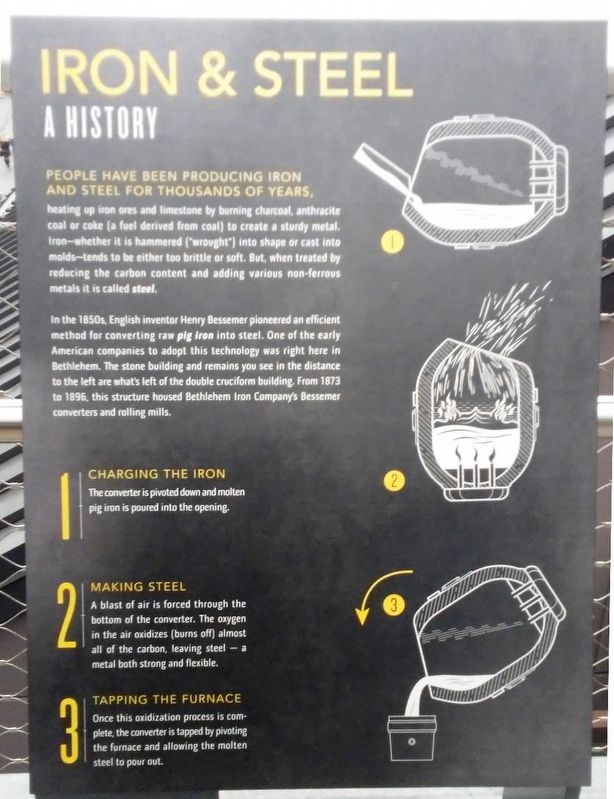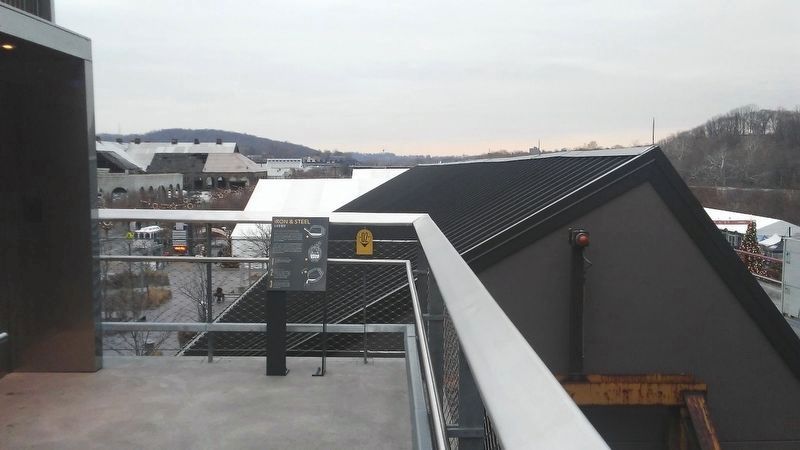Iron and Steel: A History
People have been producing iron and steel for thousands of years, heating up iron ores and limestone by burning charcoal, anthracite coal or coke (a fuel derived from coal) to create a sturdy metal. Iron-whether it is hammered ("wrought") into shape or cast into molds-tends to be either too brittle or soft. But, when treated by reducing the carbon content and adding various non-ferrous metals it is called steel.
In the 1850s, English inventory Henry Bessemer pioneered an efficient method for converting raw pig iron into steel. One of the earliest American companies to adopt this technology was right here in Bethlehem. The stone building and remains you see in the distance to the left are what's left of the double cruciform building. From 1873 to 1896, this structure housed Bethlehem Iron Company's Bessemer converters and rolling mills.
[Illustration key]
1 Charging the Iron
The converter is pivoted down and molten pig iron is poured into the opening.
2 Making Steel
A blast of air is forced through the bottom of the converter. The oxygen in the air oxidizes (burns off) almost all of the carbon, leaving steel - a metal both strong and flexible.
3 Tapping the Furnace
Once this oxidation process is complete, the converter is tapped by pivoting
Erected by SteelStacks. (Marker Number 2.)
Topics. This historical marker is listed in this topic list: Industry & Commerce. A significant historical year for this entry is 1873.
Location. 40° 36.89′ N, 75° 22.143′ W. Marker is in Bethlehem, Pennsylvania, in Northampton County. Marker is on the Hoover-Mason Trestle at SteelStacks, next to the elevator. Touch for map. Marker is at or near this postal address: 711 East 1st Street, Bethlehem PA 18015, United States of America. Touch for directions.
Other nearby markers. At least 8 other markers are within walking distance of this marker. The Beginnings of Bethlehem Steel (a few steps from this marker); Moving Materials (within shouting distance of this marker); Blast Furnace (within shouting distance of this marker); Immigration & Industry (within shouting distance of this marker); Making Iron (about 300 feet away, measured in a direct line); Hot, Loud, & Dangerous (about 400 feet away); A Community of Workers (about 400 feet away); Air Products (about 400 feet away). Touch for a list and map of all markers in Bethlehem.
More about this marker. Marker is on the grounds of the former Bethlehem Steel plant.
Also see . . .
1. Bethlehem Steel. Britannica entry (Submitted on December 24, 2017, by William Fischer, Jr. of Scranton, Pennsylvania.)
2. What is SteelStacks?. Website homepage (Submitted on December 24, 2017, by William Fischer, Jr. of Scranton, Pennsylvania.)
3. Henry Bessemer. American Society of Mechanical Engineers website entry (Submitted on December 24, 2017, by William Fischer, Jr. of Scranton, Pennsylvania.)
4. The Bessemer Process. Econproph website entry (Submitted on December 24, 2017, by William Fischer, Jr. of Scranton, Pennsylvania.)
Credits. This page was last revised on October 30, 2023. It was originally submitted on December 24, 2017, by William Fischer, Jr. of Scranton, Pennsylvania. This page has been viewed 195 times since then and 14 times this year. Photos: 1, 2. submitted on December 24, 2017, by William Fischer, Jr. of Scranton, Pennsylvania.

